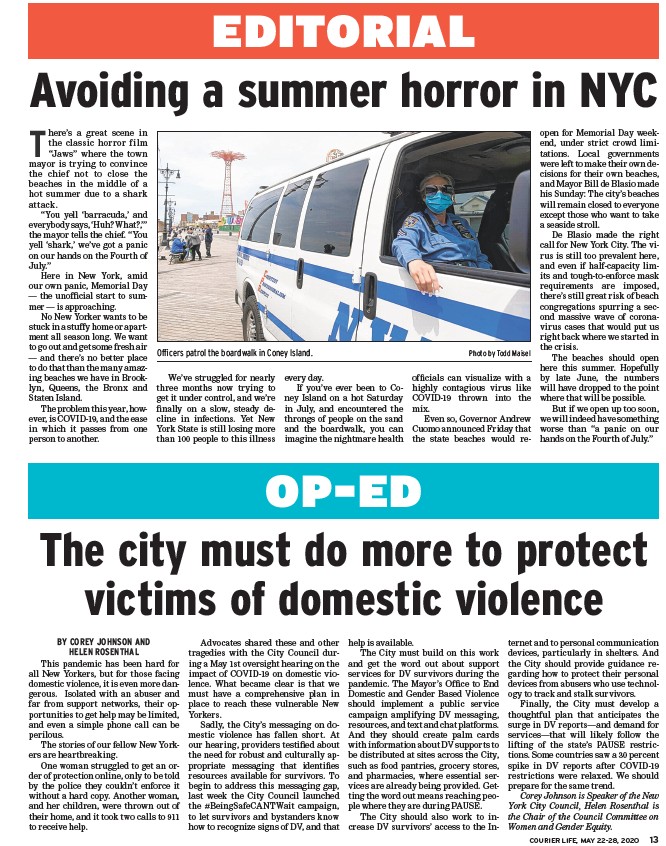
Avoiding a summer horror in NYC
The city must do more to protect
victims of domestic violence
COURIER LIFE, MAY 22-28, 2020 13
OP-ED
BY COREY JOHNSON AND
HELEN ROSENTHAL
This pandemic has been hard for
all New Yorkers, but for those facing
domestic violence, it is even more dangerous.
Isolated with an abuser and
far from support networks, their opportunities
to get help may be limited,
and even a simple phone call can be
perilous.
The stories of our fellow New Yorkers
are heartbreaking.
One woman struggled to get an order
of protection online, only to be told
by the police they couldn’t enforce it
without a hard copy. Another woman,
and her children, were thrown out of
their home, and it took two calls to 911
to receive help.
Advocates shared these and other
tragedies with the City Council during
a May 1st oversight hearing on the
impact of COVID-19 on domestic violence.
What became clear is that we
must have a comprehensive plan in
place to reach these vulnerable New
Yorkers.
Sadly, the City’s messaging on domestic
violence has fallen short. At
our hearing, providers testifi ed about
the need for robust and culturally appropriate
messaging that identifi es
resources available for survivors. To
begin to address this messaging gap,
last week the City Council launched
the #BeingSafeCANTWait campaign,
to let survivors and bystanders know
how to recognize signs of DV, and that
help is available.
The City must build on this work
and get the word out about support
services for DV survivors during the
pandemic. The Mayor’s Offi ce to End
Domestic and Gender Based Violence
should implement a public service
campaign amplifying DV messaging,
resources, and text and chat platforms.
And they should create palm cards
with information about DV supports to
be distributed at sites across the City,
such as food pantries, grocery stores,
and pharmacies, where essential services
are already being provided. Getting
the word out means reaching people
where they are during PAUSE.
The City should also work to increase
DV survivors’ access to the Internet
and to personal communication
devices, particularly in shelters. And
the City should provide guidance regarding
how to protect their personal
devices from abusers who use technology
to track and stalk survivors.
Finally, the City must develop a
thoughtful plan that anticipates the
surge in DV reports—and demand for
services—that will likely follow the
lifting of the state’s PAUSE restrictions.
Some countries saw a 30 percent
spike in DV reports after COVID-19
restrictions were relaxed. We should
prepare for the same trend.
Corey Johnson is Speaker of the New
York City Council, Helen Rosenthal is
the Chair of the Council Committee on
Women and Gender Equity.
There’s a great scene in
the classic horror film
“Jaws” where the town
mayor is trying to convince
the chief not to close the
beaches in the middle of a
hot summer due to a shark
attack.
“You yell ‘barracuda,’ and
everybody says, ‘Huh? What?,’”
the mayor tells the chief. “You
yell ‘shark,’ we’ve got a panic
on our hands on the Fourth of
July.”
Here in New York, amid
our own panic, Memorial Day
— the unoffi cial start to summer
— is approaching.
No New Yorker wants to be
stuck in a stuffy home or apartment
all season long. We want
to go out and get some fresh air
— and there’s no better place
to do that than the many amazing
beaches we have in Brooklyn,
Queens, the Bronx and
Staten Island.
The problem this year, however,
is COVID-19, and the ease
in which it passes from one
person to another.
We’ve struggled for nearly
three months now trying to
get it under control, and we’re
fi nally on a slow, steady decline
in infections. Yet New
York State is still losing more
than 100 people to this illness
every day.
If you’ve ever been to Coney
Island on a hot Saturday
in July, and encountered the
throngs of people on the sand
and the boardwalk, you can
imagine the nightmare health
offi cials can visualize with a
highly contagious virus like
COVID-19 thrown into the
mix.
Even so, Governor Andrew
Cuomo announced Friday that
the state beaches would reopen
for Memorial Day weekend,
under strict crowd limitations.
Local governments
were left to make their own decisions
for their own beaches,
and Mayor Bill de Blasio made
his Sunday: The city’s beaches
will remain closed to everyone
except those who want to take
a seaside stroll.
De Blasio made the right
call for New York City. The virus
is still too prevalent here,
and even if half-capacity limits
and tough-to-enforce mask
requirements are imposed,
there’s still great risk of beach
congregations spurring a second
massive wave of coronavirus
cases that would put us
right back where we started in
the crisis.
The beaches should open
here this summer. Hopefully
by late June, the numbers
will have dropped to the point
where that will be possible.
But if we open up too soon,
we will indeed have something
worse than “a panic on our
hands on the Fourth of July.”
EDITORIAL
Offi cers patrol the boardwalk in Coney Island. Photo by Todd Maisel